Mike Kuo (郭正光) wasn’t in Penghu’s Jhenhai Junior High School (鎮海國中) last week to discuss politics; instead he talked about testing water filters in zero gravity and developing sweet-and-sour pork for astronauts.
The former president of the US-based Formosa Association for Public Affairs may be known to Taipei Times readers for his opinion pieces, but Kuo also spends part of his visits to Taiwan talking to students about his 38-year career as a food scientist for NASA.
Kuo joined NASA in 1980, when it was recruiting for food experts for its Space Shuttle program, which launched its first flight in April 1981. His presentation is a fascinating journey from the 1960s, where astronauts munched on dry compressed chicken powder, to the modern day where they can enjoy fresh vegetables and chef-created meals.
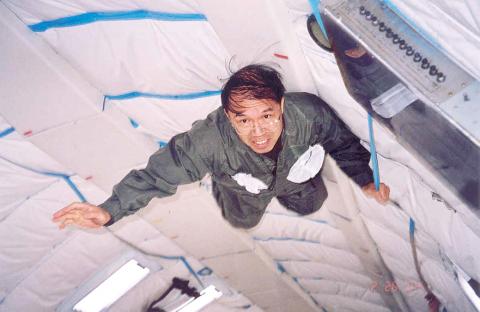
Photo courtesy of Mike Kuo
Although nutrition, such as making up for calcium loss which is faster in space, is the main objective, Kuo says a significant part is to find ways to satisfy the astronauts’ appetites. His team has developed at least 80 types of food and 20 drinks over the years, covering the cuisine of the diverse crew on the International Space Station (ISS).
“For example, someone wanted sweet-and-sour pork, so we freeze dried fried pork and experimented with sugar, vinegar and tomato powder,” Kuo says. “We try to make their dining experience as similar to the conditions on Earth as possible. Eating is one of their main sources of enjoyment up there.”
SPACE FOOD EVOLUTION
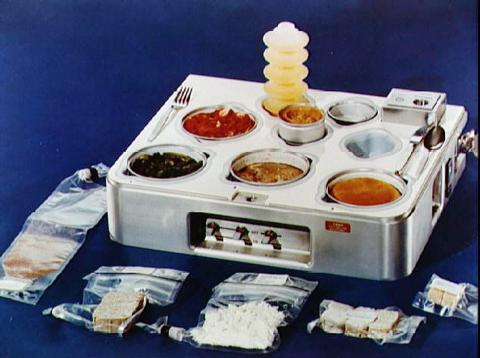
Photo courtesy of Mike Kuo
Space food has come a long way, as Kuo shows photos of how it has evolved over the decades. It’s evident that the food scientists aren’t just trying to simulate food on Earth, but also the dining environment. Instead of just sucking out what looks like baby food from a packet in the early days, Kuo says they want the astronauts to be able to sit down and eat properly.
They even tried using hard plastic containers to resemble bowls at one point, but found it too heavy and bulky.
“It costs US$10,000 to send one pound of material into space,” Kuo says. “We have to minimize what they bring.”
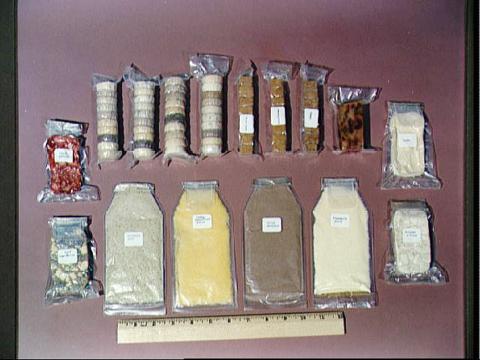
Photo courtesy of Mike Kuo
All food needs to last at least two years. A photo of a standard meal includes Chessmen cookies, kidney beans, a sausage patty, pudding, Life Savers candy and lemonade. The innovations in the field continue, as astronauts can now grow fresh vegetables on board, and in October last year ISS astronauts were able to use 3D bioprinting to create artificial beef.
Kuo says that at first, his team designed strict daily meals for the astronauts to make sure they were getting adequate nutrition. But after finding out that many weren’t following the plan, NASA switched to a bar code system so they could at least track what the astronauts ate and advise accordingly.
Astronauts have reported that their taste buds tend to dull in space, and many reports show that they prefer sharper and spicier foods — evidenced with the immense popularity of Tabasco sauce aboard the ISS. While astronauts can also add salt and pepper water to their food, Kuo says too much salt can increase calcium loss, which is one of the major nutritional issues in zero gravity.
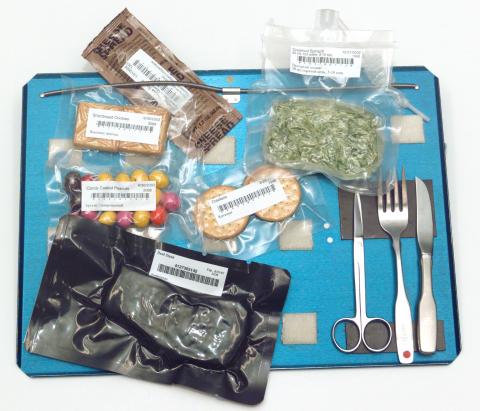
Photo courtesy of Mike Kuo
PRACTICAL ISSUES
Kuo spent at least five years testing ways to reduce calcium loss through diet. His team found that they could simulate space calcium loss conditions on Earth by having people lie down at a certain angle, and paid homeless people to serve as test subjects from four to 26 weeks.
Besides eating less meat and taking osteoporosis medication, they found that there was not much they could do, Kuo says.
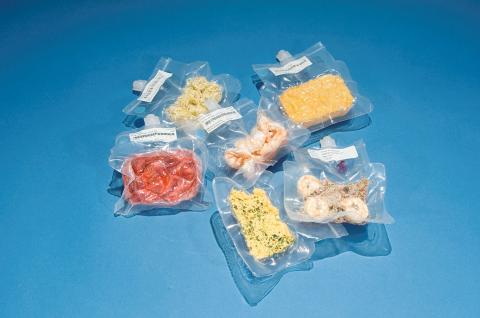
Photo courtesy of Mike Kuo
For the past decade up until his retirement in 2018, Kuo focused on providing a steady source of drinkable water in space. With the end of the Space Shuttle program in 2011, it became more difficult to transport water to astronauts. Plus, the technology was also needed if the US wanted to build long-term space stations on the moon or Mars.
Kuo helped develop a three-step filtration system to purify the astronauts’ urine — currently their technology can recover 80 percent of the water and levels purer than drinking water found on Earth. He shows a picture of two astronauts toasting to their own urine. Interestingly, up until at least 2015, the Russians on the ISS refused to drink their own urine, using a different filtration system that dealt with other wastewater.
The most exciting opportunity for Kuo brought by this project was the chance to experience zero gravity, since the filtration machines needed to be tested in space conditions. The scientists would get into a plane that would launch at a steep angle and then abruptly level. This creates a 25 to 30 second window of weightlessness that Kuo had to test his machines. The plane could repeat this maneuver up to 40 times a day.
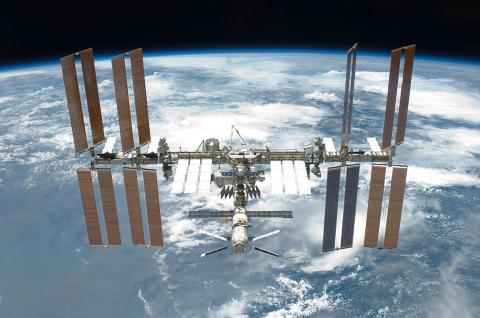
Photo courtesy of Wikimedia Commons
“I’m very proud of having the chance to do this,” Kuo says, adding that while he had two vomit bags on him during the process, he never threw up. “I don’t think many Taiwanese have experienced zero gravity.”

Wooden houses wedged between concrete, crumbling brick facades with roofs gaping to the sky, and tiled art deco buildings down narrow alleyways: Taichung Central District’s (中區) aging architecture reveals both the allure and reality of the old downtown. From Indigenous settlement to capital under Qing Dynasty rule through to Japanese colonization, Taichung’s Central District holds a long and layered history. The bygone beauty of its streets once earned it the nickname “Little Kyoto.” Since the late eighties, however, the shifting of economic and government centers westward signaled a gradual decline in the area’s evolving fortunes. With the regeneration of the once

Even by the standards of Ukraine’s International Legion, which comprises volunteers from over 55 countries, Han has an unusual backstory. Born in Taichung, he grew up in Costa Rica — then one of Taiwan’s diplomatic allies — where a relative worked for the embassy. After attending an American international high school in San Jose, Costa Rica’s capital, Han — who prefers to use only his given name for OPSEC (operations security) reasons — moved to the US in his teens. He attended Penn State University before returning to Taiwan to work in the semiconductor industry in Kaohsiung, where he

On May 2, Chinese Nationalist Party (KMT) Chairman Eric Chu (朱立倫), at a meeting in support of Taipei city councilors at party headquarters, compared President William Lai (賴清德) to Hitler. Chu claimed that unlike any other democracy worldwide in history, no other leader was rooting out opposing parties like Lai and the Democratic Progressive Party (DPP). That his statements are wildly inaccurate was not the point. It was a rallying cry, not a history lesson. This was intentional to provoke the international diplomatic community into a response, which was promptly provided. Both the German and Israeli offices issued statements on Facebook

Perched on Thailand’s border with Myanmar, Arunothai is a dusty crossroads town, a nowheresville that could be the setting of some Southeast Asian spaghetti Western. Its main street is the final, dead-end section of the two-lane highway from Chiang Mai, Thailand’s second largest city 120kms south, and the heart of the kingdom’s mountainous north. At the town boundary, a Chinese-style arch capped with dragons also bears Thai script declaring fealty to Bangkok’s royal family: “Long live the King!” Further on, Chinese lanterns line the main street, and on the hillsides, courtyard homes sit among warrens of narrow, winding alleyways and